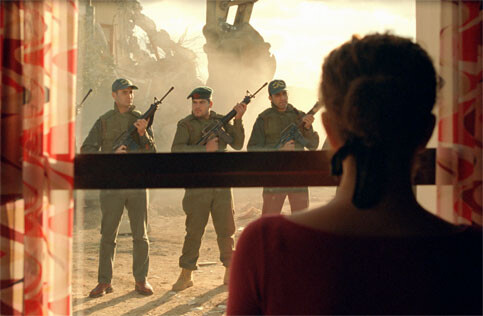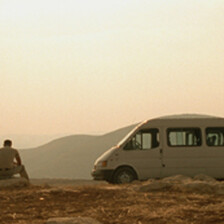The Electronic Intifada 7 March 2010

A scene from Rana’s Wedding
Nazareth-born filmmaker Hany Abu-Assad is best known internationally for his 2005 film Paradise Now about two young, attractive Palestinian men from Nablus in the occupied West Bank who are drawn into a suicide bombing mission in Tel Aviv. It was nominated for an Academy Award in the Best Foreign Language Film category.
A Dutch-educated filmmaker, Abu-Assad’s filmmaking career began in the early 1990s when he decided to shift from being an airplane engineer to a TV and film producer. A series of documentaries and short films followed, but it wasn’t until his 2002 film Rana’s Wedding, filmed during the early months of the second Palestinian intifada, that he started to get noticed in more international circles. The Electronic Intifada contributor Sabah Haider spoke with Hany Abu-Assad about how his films are received, Palestinian cinema and the challenges of filmmaking.
Sabah Haider: Are the themes that bind Palestinian films together the same themes that bind Palestinians as a people, a stateless people, together?
Hany Abu-Assad: We have more in common than that. We have our biggest shared interest, which is our case, our struggle. But we have our culture, Arab and Islamic culture. We are part of that culture, the language, the sense of humor. Our case is our priority and our instinct is that we can’t accept injustice. We are fragmented, but still we share a strong culture and language, which amongst the people isn’t just a movement, it’s also an identity and a set of values that is shared. We can’t accept injustice, even when it’s stronger than us.
SH: These themes include the resistance, trauma, statelessness and a longing for the return to Palestine, the right to return.
HA: For sure the dominant one is trauma. The right to return, let’s say, is absolutely dominant, but the trauma is part of that because the solution to the trauma is the right to return. Trauma is a consequence of the Nakba [the expulsion of Palestinians from their homeland]. After that you resist, you keep the spirit alive, you keep the case alive, you try to understand. Part of the trauma is that you try to understand the complexity of the Israeli side. Part of the trauma is that you insist on the right of return — it’s a big thing happening to you. Psychological trauma, physical trauma and unconscious trauma, it’s all one big thing. Even after we get our rights back, we still have to recover from that trauma.
SH: How would you define Palestinian cinema?
HA: Since 1948 we are a resistance movement and keeping the case alive is a form of resistance. Making these films is like unconsciously making documents that can be kept in history and keep your case alive. It’s a way of resistance.
SH: Would you agree that the films that are classified as being in and of Palestinian cinema are bound by certain themes?
HA: Until this moment, consciously or unconsciously, there is the fight against the aggressor. The resistance against the aggressor is the common theme, sometimes in a small story or sometimes indirectly. Whatever your power is, the human voice is much stronger. Through military power, economic and political power they try to limit your human and basic rights. By not giving up it becomes a theme — not giving up and continuing with your life and identity.
SH: Your film Rana’s Wedding was produced soon after the second Palestinian intifada broke out. What challenges did that pose? How did that impact the film?
HA: If it happened, it happened unconsciously, as I couldn’t allow myself to be influenced by the general mood. You want to tell a story and the production is dictated by that — by a story-driven construction. Part of the trauma is to make sure that people understand. I was very aware of exposing the themes in Rana’s Wedding, I was very much explaining and exposing what’s going on in the situation rather than the traumatic experience, and we have a self-censor, I was so scared to explain what’s going on.
SH: Did the mood among Palestinian filmmakers reflect the overall mood among Palestinians at the time?
HA: For sure the intifada influenced the production because at the end of the film, reality is stronger than fiction. The occupation, the checkpoints — you don’t want them to interfere with your story but the ugliness of occupation influenced the look of film. As much as you might not want occupation to influence the making of the film, at the end it does influence it.
The mood among the general population and Palestinian filmmakers was [the same]. What the general population went through, we went through too. You feel angry and impotent. You feel you can’t do anything against this heartless operation going on. … I always tell the same story at festivals, but the difference is that you can be at a festival and be celebrated and you are treated as very important person, but when you go back to your homeland you are treated as non-human. I could be in Rome at a festival and be celebrated and the same day I can go back and be treated as a criminal. This contrast is amazing. The mood is the same among all Palestinians under occupation — you are the same as anyone else and are not protected.
SH: The characters in your films can be read as being positive and filled with hope. Is that intentional?
HA: I believe the most important part of resistance is hope, and the enemy is so strong. The Zionist movement is so strong and it’s not easy to fight with them, but without hope you can’t maintain the movement of resistance and you have to keep the hope alive. Still I believe that there is no way out — one way is creating hope in order to continue our struggle. Rana [the protagonist in Rana’s Wedding] has more hope than her husband.
SH: How do Palestinians receive films that aspire to represent them?
HA: The problem with our cinema is that we don’t have [our] distribution channels to our people. Every nation has its own distribution channels to its people but we don’t have that — we are relying on other channels, but we can’t massively achieve that.
There was a more positive hope at the beginning of the second intifada than there is now. There was more hope, I shot the movie before the invasion and siege of [then Palestinian Authority President Yasser] Arafat at the time. A few weeks before, it was at the beginning of the intifada, and at the time there was great hope.
Most of the Palestinians — especially the young ones — have hope. I believe that with the Palestinian people in the diaspora, their tragedy is so big, that they don’t see the end of the tunnel. Their existence [as refugees for] 60 years is because of the cowardice of Arab people, the leaders — the cowardice of the elite of the Arabs, their impotence, their unwillingness to fight or to sacrifice.
Israel is pushing everybody to a point of fundamentalism. At a certain point nobody cares anymore. They are pushing the situation to a path that is self-destructive, and the resistance is growing. The amount of awareness against the Zionist state has never been as big as it is now. And this was inevitable.
Editor’s note: due to a formatting error the interviewer’s insertion that “These themes include the resistance, trauma, statelessness and a longing for the return to Palestine, the right to return” was not marked as such. This version of the article is corrected for that clarification.
Sabah Haider is a Canadian journalist and filmmaker based in Beirut. She can be reached via email at sabafhaider A T gmail D O T com.

